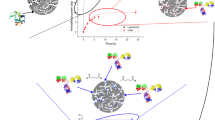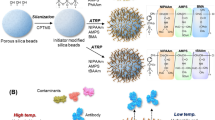Abstract
The mixed-mode resins for protein adsorption have been prepared by a novel strategy, copolymer grafting. Specially, the copolymer-grafted resins CG-M-A with two functional groups, 5-amino-benzimidazole (ABI) and methacryloxyethyltrimethyl ammonium chloride (METAC), have been prepared through surface-initiated activator generated by electron transfer for atom transfer radical polymerization of METAC and glycidyl methacrylate (GMA), followed by a ring-open reaction to introduce ABI. The charge and hydrophobicity of CG-MA resins could be controlled by manipulating the addition of METAC and GMA/ABI. Besides, METAC and ABI provided positive effects together in both protein adsorption and elution: dynamic binding capacity of human Immunoglobulin G (hIgG) onto CG-M-A resin with the highest ligand ratio of METAC to ABI is 46.8 mg∙g–1 at pH 9 and the elution recovery of hIgG is 97.0% at pH 5. The separation experiment showed that purity and recovery of monoclonal antibody from cell culture supernatant are 96.0% and 86.5%, respectively, indicating that copolymer-grafted mixed-mode resins could be used for antibody purification.

Similar content being viewed by others
References
Gao D, Wang L L, Lin D Q, Yao S J. Evaluating antibody monomer separation from associated aggregates using mixed-mode chromatography. Journal of Chromatography A, 2013, 1294: 70–75
Zhao G, Dong X Y, Sun Y. Ligands for mixed-mode protein chromatography: Principles, characteristics and design. Journal of Biotechnology, 2009, 144(1): 3–11
Kallberg K, Johansson H O, Bulow L. Multimodal chromatography: An efficient tool in downstream processing of proteins. Biotechnology Journal, 2012, 7(12): 1485–1495
Zhu M, Carta G. Protein adsorption equilibrium and kinetics in multimodal cation exchange resins. Adsorption, 2016, 22(2): 165–179
Wang X, Bo C, Wang C, Wei Y. Controllable preparation of a hydrophilic/ion-exchange mixed-mode stationary phase by surfaceinitiated atom transfer radical polymerization using a mixture of two functional monomers. Journal of Separation Science, 2017, 40(9): 1861–1868
Gagnon P, Hensel F, Lee S, Zaidi S. Chromatographic behavior of IgM:DNA complexes. Journal of Chromatography A, 2011, 1218 (17): 2405–2412
Chen J, Tetrault J, Ley A. Comparison of standard and new generation hydrophobic interaction chromatography resins in the monoclonal antibody purification process. Journal of Chromatography A, 2008, 1177(2): 272–281
Brenac Brochier V, Schapman A, Santambien P, Britsch L. Fast purification process optimization using mixed-mode chromatography sorbents in pre-packed mini-columns. Journal of Chromatography A, 2008, 1177(2): 226–233
Menegatti S, Hussain M, Naik A D, Carbonell R G, Rao B M. mRNA display selection and solid-phase synthesis of Fc-binding cyclic peptide affinity ligands. Biotechnology and Bioengineering, 2013, 110(3): 857–870
Tong H F, Lin D Q, Chu WN, Zhang Q L, Gao D, Wang R Z, Yao S J. Multimodal charge-induction chromatography for antibody purification. Journal of Chromatography A, 2016, 1429: 258–264
Wang R Z, Lin D Q, Chu W N, Zhang Q L, Yao S J. New tetrapeptide ligands designed for antibody purification with biomimetic chromatography: Molecular simulation and experimental validation. Biochemical Engineering Journal, 2016, 114: 191–201
Yu L, Liu N, Hong Y, Sun Y. Protein adsorption and chromatography on novel mixed-mode resins fabricated from butyl-modified poly(ethylenimine)-grafted Sepharose. Chemical Engineering Science, 2015, 135: 223–231
Ruaan R C, Yang A, Hsu D. Bifunctional adsorbents for hydrophobic displacement chromatography of proteins. Biotechnology Progress, 2000, 16(6): 1132–1134
Li Y, Sun Y. Poly(4-vinylpyridine): a polymeric ligand for mixedmode protein chromatography. Journal of Chromatography A, 2014, 1373: 97–105
Liu T, Lin D Q, Lu H L, Yao S J. Preparation and evaluation of dextran-grafted agarose resin for hydrophobic charge-induction chromatography. Journal of Chromatography A, 2014, 1369: 116–124
Liu T, Lin D Q, Wu Q C, Zhang Q L, Wang C X, Yao S J. A novel polymer-grafted hydrophobic charge-induction chromatographic resin for enhancing protein adsorption capacity. Chemical Engineering Journal, 2016, 304: 251–258
Lu H L, Lin D Q, Zhu M M, Yao S J. Protein adsorption on DEAE ion-exchange resins with different ligand densities and pore sizes. Journal of Separation Science, 2012, 35(22): 3084–3090
Yu L L, Tao S P, Dong X Y, Sun Y. Protein adsorption to poly (ethylenimine)-modified Sepharose FF: I. a critical ionic capacity for drastically enhanced capacity and uptake kinetics. Journal of Chromatography A, 2013, 1305: 76–84
Wang C X, Lin D Q, Liu T, Yao S J. Hydrophobic charge-induction chromatographic resin with 5-aminobenzimidazol ligand: Effects of ligand density on protein adsorption. Separation Science and Technology, 2016, 51(10): 1700–1707
Angelo J M, Cvetkovic A, Gantier R, Lenhoff A M. Characterization of cross-linked cellulosic ion-exchange adsorbents: 2. Protein sorption and transport. Journal of Chromatography A, 2016, 1438: 100–112
Liu T, Angelo J M, Lin D Q, Lenhoff A M, Yao S J. Characterization of dextran-grafted hydrophobic charge-induction resins: Structural properties, protein adsorption and transport. Journal of Chromatography A, 2017, 1517: 44–53
DePhillips P, Lenhoff A M. Pore size distributions of cationexchange adsorbents determined by inverse size-exclusion chromatography. Journal of Chromatography A, 2000, 883(1–2): 39–54
Kremer M, Pothmann E, Roessler T, Baker J, Yee A, Blanch H, Prausnitz J M. Pore-size distributions of cationic polyacrylamide hydrogels varying in initial monomer concentration and crosslinker-monomer ratio. Macromolecules, 1994, 27(11): 2965–2973
Bhambure R, Gillespie C M, Phillips M, Graalfs H, Lenhoff A M. Ionic strength-dependent changes in tentacular ion exchangers with variable ligand density. I. Structural properties. Journal of Chromatography A, 2016, 1463: 90–101
Stone M C, Carta G. Protein adsorption and transport in agarose and dextran-grafted agarose media for ion exchange chromatography. Journal of Chromatography A, 2007, 1146(2): 202–215
Yu L L, Sun Y. Protein adsorption to poly(ethylenimine)-modified Sepharose FF: II. effect of ionic strength. Journal of Chromatography A, 2013, 1305: 85–93
Thomas H, Coquebert de Neuville B, Storti G, Morbidelli M, Joehnck M, Schulte M. Role of tentacles and protein loading on pore accessibility and mass transfer in cation exchange materials for proteins. Journal of Chromatography A, 2013, 1285: 48–56
Yuan X M, Lin D Q, Zhang Q L, Gao D, Yao S J. A microcalorimetric study of molecular interactions between immunoglobulin G and hydrophobic charge-induction ligand. Journal of Chromatography A, 2016, 1443: 145–151
Tong H F, Lin D Q, Yuan X M, Yao S J. Enhancing IgG purification from serum albumin containing feedstock with hydrophobic chargeinduction chromatography. Journal of Chromatography A, 2012, 1244: 116–122
Burton S C, Harding D R. Hydrophobic charge induction chromatography: Salt independent protein adsorption and facile elution with aqueous buffers. Journal of Chromatography A, 1998, 814(1–2): 71–81
Mazzer A R, Perraud X, Halley J, O’Hara J, Bracewell D G. Protein A chromatography increases monoclonal antibody aggregation rate during subsequent low pH virus inactivation hold. Journal of Chromatography A, 2015, 1415: 83–90
Gagnon P, Nian R, Leong D, Hoi A. Transient conformational modification of immunoglobulin G during purification by protein A affinity chromatography. Journal of Chromatography A, 2015, 1395: 136–142
Acknowledgements
This work was supported by the National Natural Science Foundation of China. The authors have declared no conflict of interest.
Author information
Authors and Affiliations
Corresponding author
Electronic supplementary material
Rights and permissions
About this article
Cite this article
Chen, S., Liu, T., Yang, R. et al. Preparation of copolymer-grafted mixed-mode resins for immunoglobulin G adsorption. Front. Chem. Sci. Eng. 13, 70–79 (2019). https://doi.org/10.1007/s11705-018-1745-4
Received:
Accepted:
Published:
Issue Date:
DOI: https://doi.org/10.1007/s11705-018-1745-4




